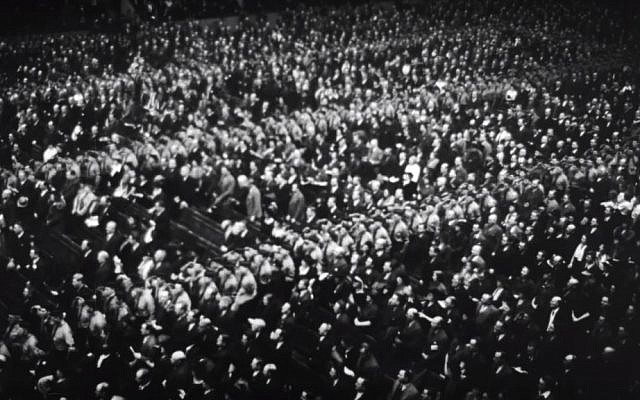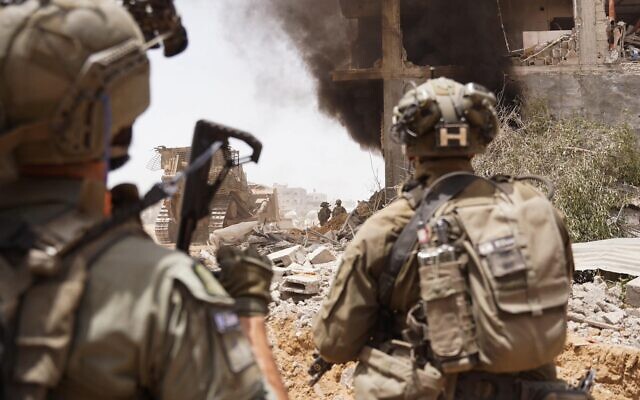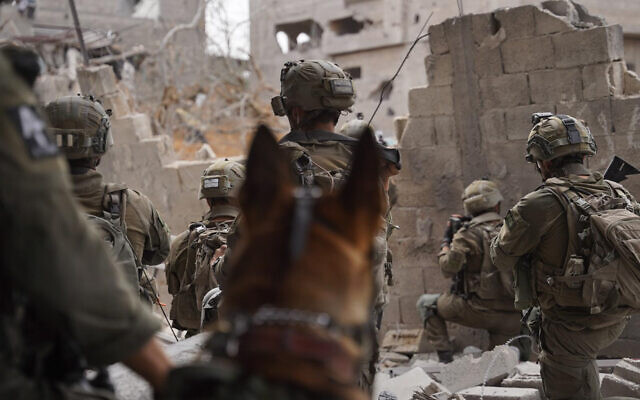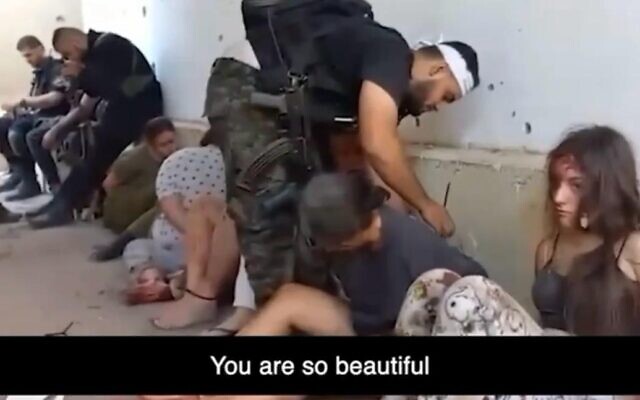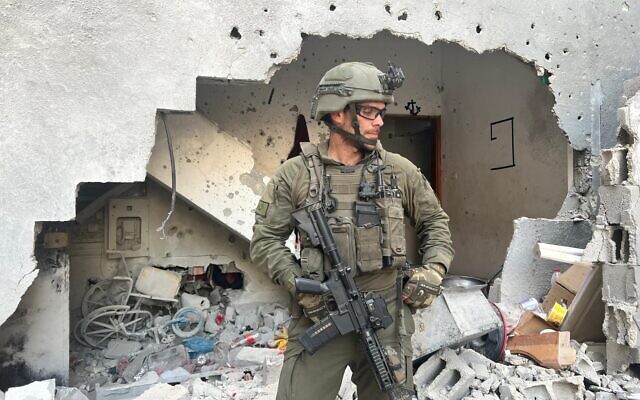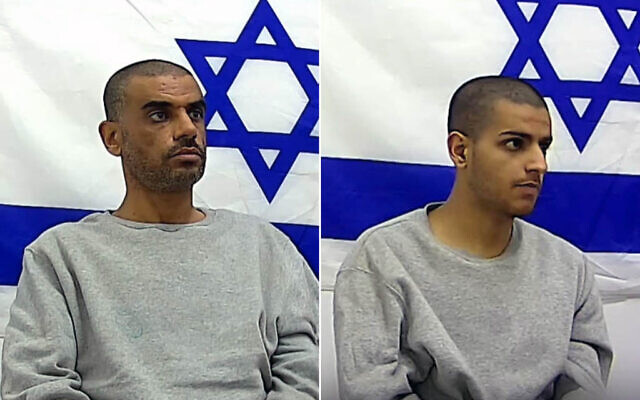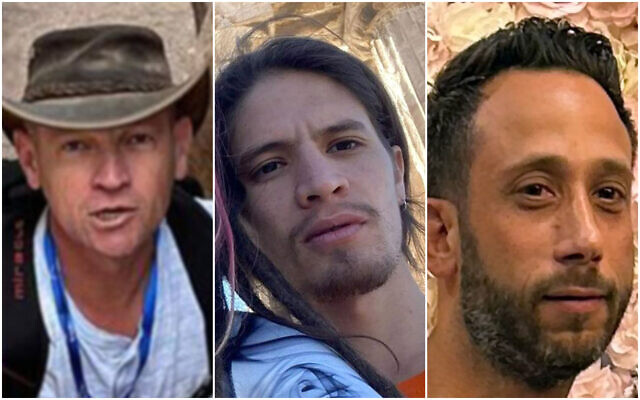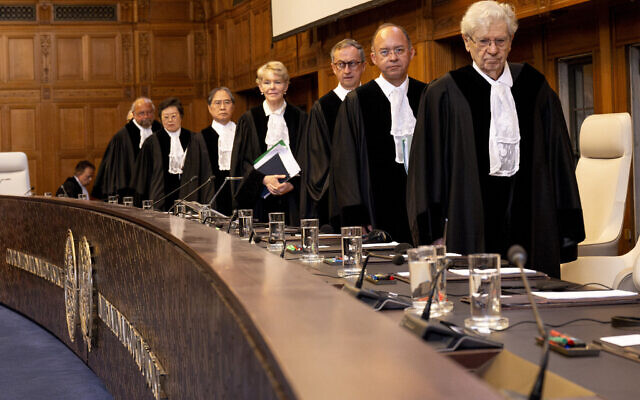When a Jewish laborer took on 20,000 US Nazis in Madison Square Garden
Documentary compiles archive footage to recall 1939 German American Bund rally in New York, and the Jew who tried to disrupt it
A new short documentary compiles archived footage to recall an event held in New York on the eve of World War II in which tens of thousands of people gathered at New York’s iconic Madison Square Garden venue to cheer on US Nazis at what was billed as a “pro-American rally.”
Documentary filmmaker Marshall Curry’s latest work includes the moments when a Jewish man was beaten to the floor as he tried to rush past dozens of uniformed Nazis on the stage in a failed attempt to disrupt the main speaker.
The seven-minute “A Night at the Garden” is made up of various clips showing the drama on the night of February 20, 1939, when 20,000 people packed into Madison Square Garden for a rally organized by the German American Bund, a Nazi movement led by German-American Fritz Julius Kuhn.
The film was recently screened at 22 US cinemas in the Alamo theater chain.
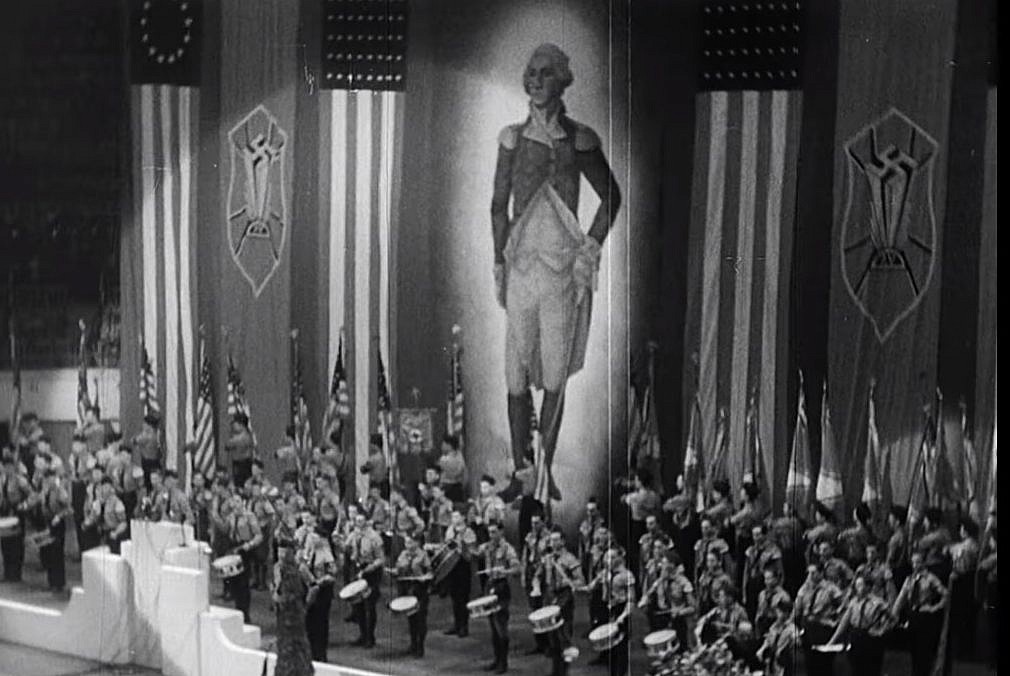
Curry made the film for the documentary unit Field of Vision after learning about the history of the rally a year ago.
In an interview published last week on the Field of Vision website, the director talked about the film and its significance to modern society.
“Events like this should remind us not to be complacent — that the things we care about have to be nurtured and defended regularly — because even seemingly good people have the potential to do hideous things,” he said.

American neo-Nazis and US white supremacists made headlines recently after an August nationalist rally held in Charlottesville, Virginia, dissolved into clashes and deadly violence when an alleged white supremacist drove his car into counterprotesters, killing 32-year-old Heather Heyer.
In the black and white footage from 1939 rally, uniformed American Nazis carrying swastika flags are seen parading up to the stage, where a 30-foot-high poster of George Washington is surrounded by US flags and swastika banners. During the proceedings the crowd also sings “The Star Spangled Banner.”
At the time the rally was held, Nazi Germany under Adolf Hitler was already operating several concentration camps as part of the persecution of Jews and political opponents that led to the murder of six million Jewish people across Europe. On September 1, 1939, German invaded Poland, launching World War II, which the US joined in 1941 after the Japanese bombing of Pearl Harbor on December 7 of that year.
Kuhn, who was born 1896 in Baden-Wurttemberg in Germany, moved to the US in 1928 and became a naturalized citizen in 1934, took to the stage wearing a Bund military-styled uniform. In German-accented English he mocked the “Jewish media” and then, to wild applause, called for a “white, gentile-ruled United States… gentile-controlled labor unions, free from Jewish Moscow-directed domination.”
“It really illustrated that the tactics of demagogues have been the same throughout the ages,” filmmaker Curry explained. “They attack the press, using sarcasm and humor. They tell their followers that they are the true Americans. And they encourage their followers to ‘take their country back’ from whatever minority group has ruined it.”

A group of protesters was permitted to stand at the side of the stage during the Bund event and tens of thousands more gathered outside. As Kuhn addressed the audience, Isadore Greenbaum, 26-year-old Jewish plumber’s helper from Brooklyn, jumped onto the stage and tried to rush the podium. He was set upon by Bund members, was beaten and had his pants pulled off. Police waded into the melee and pulled him from the room. He was fined $25 for disorderly conduct, equivalent to about $430 in today’s currency.
“There was a debate at the time over whether the Bund should be allowed to have a rally, which – like so many things about the event — seems eerily contemporary,” Curry said, citing a New York Times article from the time. “Greenbaum explained to the judge the day after the rally, ‘I went down to the Garden without any intention of interrupting. But being that they talked so much against my religion and there was so much persecution I lost my head, and I felt it was my duty to talk.’
“The magistrate asked him, ‘Don’t you realize that innocent people might have been killed?’ And Greenbaum replied, ‘Do you realize that plenty of Jewish people might be killed with their persecution up there?'”
Despite the opposition to the rally, the American Jewish Committee was in favor of letting the Bund event go ahead, Curry said. At the time, the AJC told the New York Times that while the Bund was “completely anti-American and anti-Democratic… because we believe that the basic rights of free speech and free assembly must never be tampered with in the United States, we are opposed to any action to prevent the Bund from airing its views.”
“New York Mayor [Fiorello Henry] LaGuardia, for his part, ridiculed the event as an ‘exhibition of international cooties,’ and said he believed in exposing cooties to the sunlight,” Curry noted.

According to Curry, the German American Bund “had a significant presence in the 1930s, with training camps in New Jersey, upstate New York, Wisconsin, and Pennsylvania, and a huge march down East 86th Street in Manhattan. But their mainstream appeal was reduced by their leaders’ German accents and culture.”
In December 1939, Kuhn was imprisoned for embezzling Bund funds. He was stripped of his US citizenship and after the war sent to West Germany. He died in 1951.
“The Bund disappeared soon after the start of World War II,” Curry said.
“To me, the most striking and upsetting part of the film is not the anti-Semitism of the main speaker or even the violence of his storm-troopers,” said Curry. “What bothers me more is the reaction of the crowd. Twenty-thousand New Yorkers who loved their kids and were probably nice to their neighbors, came home from work that day, dressed up in suits and skirts, and went out to cheer and laugh and sing as a speaker dehumanized people who would be murdered by the millions in the next few years.”
“This point is less an indictment of bad things that Americans have done in the past, than it is a cautionary tale about the bad things that we might do in the future,” Curry warned, and then quoted prominent American Methodist minister Halford E. Luccock as saying, “When and if fascism comes to America it will not be labeled ‘made in Germany’; it will not be marked with a swastika; it will not even be called fascism; it will be called, of course, ‘Americanism.’”
Are you relying on The Times of Israel for accurate and timely coverage right now? If so, please join The Times of Israel Community. For as little as $6/month, you will:
- Support our independent journalists who are working around the clock;
- Read ToI with a clear, ads-free experience on our site, apps and emails; and
- Gain access to exclusive content shared only with the ToI Community, including exclusive webinars with our reporters and weekly letters from founding editor David Horovitz.

We’re really pleased that you’ve read X Times of Israel articles in the past month.
That’s why we started the Times of Israel eleven years ago - to provide discerning readers like you with must-read coverage of Israel and the Jewish world.
So now we have a request. Unlike other news outlets, we haven’t put up a paywall. But as the journalism we do is costly, we invite readers for whom The Times of Israel has become important to help support our work by joining The Times of Israel Community.
For as little as $6 a month you can help support our quality journalism while enjoying The Times of Israel AD-FREE, as well as accessing exclusive content available only to Times of Israel Community members.
Thank you,
David Horovitz, Founding Editor of The Times of Israel



